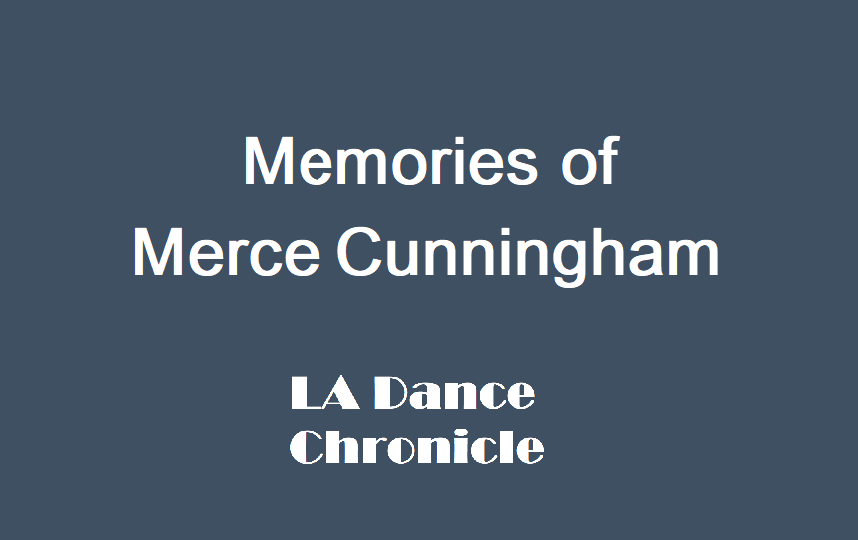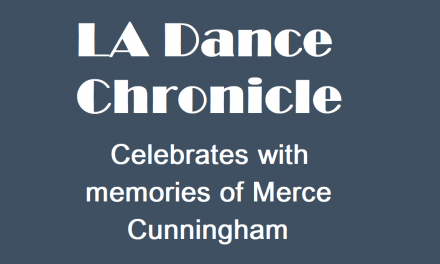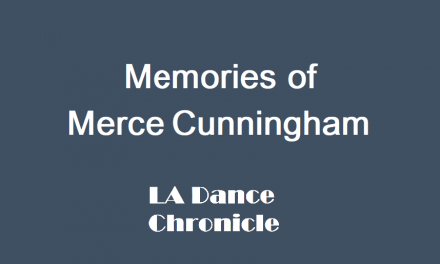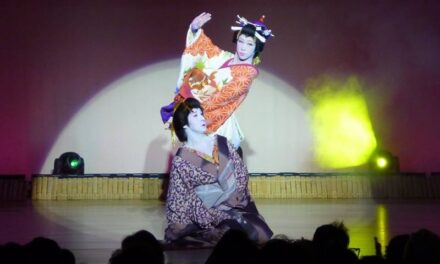My connection to the legacy of Merce Cunningham has been through legendary teachers: primarily Jeff Slayton who was my very first modern dance teacher, and then also with Brenda Daniels, Douglas Neilson, and Meg Harper. This was between 1984 – 87. I think I worked with Remy Charlip a bit during that time too.
It was because of Jeff that I got to meet these other wonderfully enlightened people, and to learn from them. I am thankful for that. I am even more thankful, though, for what I learned from Jeff directly, perhaps the most discerning of them all. I learned Cunningham technique. And I learned it not as a volume of dance knowledge, or a set of skills that one masters, or even as a style of dance. Rather, he taught us principles that were to be applied in the way that each individual finds appropriate ways to apply them. He taught me how to strengthen and align my body, challenged me to engage my imagination while moving through space, and provided an opportunity to actually EXPERIENCE MUSICALITY as something much deeper than mere accuracy of rhythm and tempo. These foundational aspects of Jeff Slayton’s teaching and artistry were, I believe, seeds initially sown within him by Merce Cunningham and Viola Farber. And these he assimilated in his own way, and shared them with many, many, many, many. How lucky are we…indeed.
Brenda Daniels too, taught me principles of precision and clarity of form. She came to CSULB to stage Cunningham’s Changing Steps. Her teaching and directing echoed what I had learned from Jeff — it is vital to have a riveted, attentive focus: 1) we must be aware of our relationship to ourselves, our parts, and how all exist relative to each other at any given moment; 2) we must be constantly aware of our relationship to other people in the space, and be aware of our relationship to the space itself at every given moment; and 3) critical at all times is our awareness of our relationship to TIME. Through learning and performing Changing Steps, I began to understand the vast performance potential I could possibly achieve if I could just be in a clear and present frame of mind. This, I believe, is the legacy of Merce Cunningham… hone your instruments of sensation, and using them, know what is happening right now. If you have ever met Jeff Slayton, or Brenda Daniels, or Doug Neilson, or Meg Harper, or Remy Charlip, or any of the thousands of wonderfully unique, interested, spirited and self propelled people/artists who have grown up around/within/nearby the Cunningham realm, you can surely appreciate the fertile soil that Merce cultivated. We have reaped glorious benefits. And we are all toiling away still. His work lives on.
I actually met Merce one day for a brief moment. He and Elliot Caplan had made a film version of Changing Steps. Somehow, Joan Schlaigh (then CSULB Dance Department Chair) had gotten the collaborators to Long Beach to share their perspective, their interests. At one point during their visit, I found an opportunity to ask Merce a question. Feeling very astute and worldly, I said “Given the deconstruction of the postmodern dance movement, where do you think the field of dance will go next?” I wish I could remember better his exact words, but basically, he tried to reassure me that art (life experience) is made by individuals, not movements. So predicting the trajectory of what might be is as allusive as determining the flames of a fire. I did not completely understand, and felt foolish and naïve for asking my question. But his response was honest. And his answer has taken a long time to fully process. Isn’t that the way with all good lessons. Thank you Merce, thank you Jeff, and thank you Brenda — for all of the lessons.
-Sean Sullivan
Associate Professor – University of North Carolina School of the Arts, School of Dance
Cal State Long Beach, Alum — 1987
I never had a direct relationship with Merce Cunningham, though I LOVED his pieces. It is clear to me that his artistry is exemplary. In so many instances, his working processes, the rigor of his dance making, as well as the consistent quality and sheer longevity of his productivity are seminal and monumental accomplishments. For me, and I’m certain many others, he stands out as THE most original dance artist of the 20th Century. There are others one could argue for, like Graham and Balanchine, who were obviously great, too, but Merce Cunningham’s work was always my favorite.
-Fred Strickler
Merce’s influence on my life as a dancer has been a gift in three chapters. Chapter 1: In 1963 as a newbie modern dance major at UCLA with only a ballet background, I remember being overwhelmed as I watched the Cunningham Company perform in Royce Hall. Merce’s presence on stage was riveting; the music was cacophony (John Cage); his dancers compelling. The choreography to my eyes was challenging, sometimes awkward, always unexpected. My naiveté was obvious. I needed more exposure to Merce Cunningham. Chapter 2: Almost ten years later (’72- ’74), I was in NYC, taking classes as often as I could from Viola Farber, an original Cunningham company member. By this time Viola had left Merce and started her own company. Her company members, especially Jeff Slayton, were phenomenal dancers: risky, strong, intelligent, amazing movers. Viola’s classes were Cunningham based with her own flavor of quirkiness, musicality and some influence of ballet from Margaret Craske. I wanted to dive in deep and learn all I could. During those same two years, I also took ballet from Margaret Craske. Her classes drew professionals from ballet and modern, including a number of former or current Cunningham company dancers: Carolyn Brown, Peter Saul, Meg Harper and several others. Inspiring to watch in a dance genre that was not their daily fare. Chapter 3: Again due to a move, I was back in Southern California. Having stayed in touch with Jeff Slayton, we re-connected. He taught modern classes at my dance studio, choreographed and eventually formed “Jeff Slayton and Dancers.” How fortunate to have come full circle; being able to take class and be a dancer in Jeff Slayton and Dancers. Jeff’s classes challenged my body and mind with morphed Cunningham technique but with the same deep roots and excitement. As a bonus, some of my community college dance students were influenced by Jeff Slayton, Cunningham technique and decided to move to NYC in order to study with Merce. The Circle of Dance. How fortunate we all were to have been touched in ways we couldn’t have conceived by the genius of Merce Cunningham.
–Karen Shanley
Around 1962 in Boston while a student at Emerson College, I had my first dance class with Merce. It was in a “settlement house” somewhere is Boston sponsored by the Dance Circle of Boston which brought dancers from New York for classes. At this class I found “GOD”, I was elated, I never knew dance before! I was the only boy in class and had to share the dressing room with Merce. Actually, it was a small library completely filled with one table and lots of chairs. Merce was at one end of the table, me at the other end…..but I HAD to speak to the Master “Gee, you use space” I mutteed. “Well, it’s there,” Merce pronounced. This simple but then, profound, statement has followed me even today. Merce became my dance mentor…forever.
-Jerry Kvasnicka
I met Merce Cunningham for the first time in 1980, while I was a program specialist at the National Endowment for the Arts. It was a few weeks after the eruption of Mount St. Helen’s. I picked him up in my old blue VW Beetle at National Airport and gave him a lift to the National Council on the Arts meeting, where he was to testify about the importance of NEA funding to his work. Also in the car were other planned speakers: Millicent Hodson, who among many dance accomplishments reconstructed Nijinsky’s Rite of Spring, and the legendary tap dancer Sandman Sims. Merce regaled us all the way to Georgetown (the meeting was underway at the Four Seasons) with stories of growing up in Washington state and learning to skip stones on Spirit Lake, which was on Mount St. Helen’s and destroyed when the mountain erupted. I was so lucky to meet him first on this very human scale. It was the beginning of many encounters with him over the years in a number of different roles including as a presenter of his work and as an audience dramaturg touring with his company doing pre-performance talks and post-performance discussions including the chance to interview him in public several times. Late last week I heard part of his 1985 interview with Terri Gross on NPR’s Fresh Air and, in the middle of the highway zooming through Gary, IN I burst into tears just hearing his voice, especially that slightly devilish, self-deprecating chuckle, again. Today marks Merce’s 100th birthday. Performance celebrations of this “marvelous” (he said that a lot when he liked something) occasion are happening in London (at the Barbican), New York (at BAM) and Los Angeles (at Royce Hall). They’ll all be live-streamed. Watch one (or more) of them if you can, and see scores of young dancers doing his steps faithfully and lovingly re-staged by members of Merce’s now-closed dance company. At Royce tonight I hope we sing a hearty happy birthday to this amazing man who gave us more than he ever realized. He was too busy making work and dancing and being fully alive. Happy birthday dear Merce! And happy Merce Day, everybody. Throw some dice and drink a glass of red wine in his honor today.
-Bonnie Brooks






